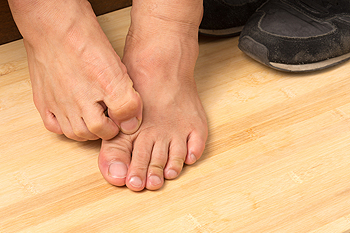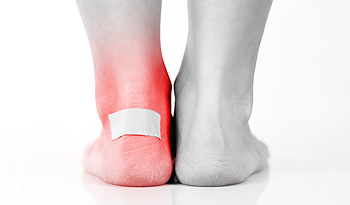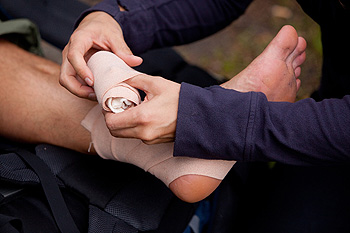 The Achilles tendon is a tough band of tissue that connects the calf muscles to the heel bone. An Achilles tendon rupture is an injury in which this tendon tears. This often happens during a sudden, forceful movement of the foot downward against resistance, for example, when an athlete pushes off the foot forcefully to jump. The symptoms of an Achilles tendon rupture is a sudden, sharp snap and intense pain in the back of the leg, an inability to point the foot downward, and difficulty walking. Swelling may also occur. If you suspect that you have ruptured your Achilles tendon, it is suggested that you seek the care of a podiatrist.
The Achilles tendon is a tough band of tissue that connects the calf muscles to the heel bone. An Achilles tendon rupture is an injury in which this tendon tears. This often happens during a sudden, forceful movement of the foot downward against resistance, for example, when an athlete pushes off the foot forcefully to jump. The symptoms of an Achilles tendon rupture is a sudden, sharp snap and intense pain in the back of the leg, an inability to point the foot downward, and difficulty walking. Swelling may also occur. If you suspect that you have ruptured your Achilles tendon, it is suggested that you seek the care of a podiatrist.
Achilles tendon injuries need immediate attention to avoid future complications. If you have any concerns, contact Bruce Smit, DPM of Frankfort Foot & Ankle Clinic. Our doctor can provide the care you need to keep you pain-free and on your feet.
What Is the Achilles Tendon?
The Achilles tendon is a tendon that connects the lower leg muscles and calf to the heel of the foot. It is the strongest tendon in the human body and is essential for making movement possible. Because this tendon is such an integral part of the body, any injuries to it can create immense difficulties and should immediately be presented to a doctor.
What Are the Symptoms of an Achilles Tendon Injury?
There are various types of injuries that can affect the Achilles tendon. The two most common injuries are Achilles tendinitis and ruptures of the tendon.
Achilles Tendinitis Symptoms
Rupture Symptoms
Treatment and Prevention
Achilles tendon injuries are diagnosed by a thorough physical evaluation, which can include an MRI. Treatment involves rest, physical therapy, and in some cases, surgery. However, various preventative measures can be taken to avoid these injuries, such as:
If you have any questions please feel free to contact our office located in Frankfort, IL . We offer the newest diagnostic tools and technology to treat your foot and ankle needs.
Flat feet is a condition in which the arch in the middle of the sole of the foot is absent, causing the entire sole of the foot to touch the ground when standing. About 30% of the population has flat feet. People with flat feet tend to have heels that point outwards from the ankles and floppier feet due to an excess of movement in the midfoot region. These can lead to various symptoms, such as pain, tenderness, or cramping in the feet or legs, and to the development of other foot conditions, including posterior tibialis tendonitis, tarsal tunnel syndrome, plantar fasciitis, ankle arthritis, overload metatarsalgia, and stress fractures in the bones of the feet. If you have flat feet that are causing you pain or discomfort, it is recommended that you seek the care of a podiatrist.
Flatfoot is a condition many people suffer from. If you have flat feet, contact Bruce Smit, DPM from Frankfort Foot & Ankle Clinic. Our doctor will treat your foot and ankle needs.
What Are Flat Feet?
Flatfoot is a condition in which the arch of the foot is depressed and the sole of the foot is almost completely in contact with the ground. About 20-30% of the population generally has flat feet because their arches never formed during growth.
Conditions & Problems:
Having flat feet makes it difficult to run or walk because of the stress placed on the ankles.
Alignment – The general alignment of your legs can be disrupted, because the ankles move inward which can cause major discomfort.
Knees – If you have complications with your knees, flat feet can be a contributor to arthritis in that area.
Symptoms
Treatment
If you are experiencing pain and stress on the foot you may weaken the posterior tibial tendon, which runs around the inside of the ankle.
If you have any questions please feel free to contact our office located in Frankfort, IL . We offer the newest diagnostic and treatment technologies for all your foot and ankle needs.
 The condition that is known as athlete’s foot can cause mild to severe irritation on the bottom of the feet or between the toes. It is caused by a fungus and is considered to be contagious. The type of fungi that can lead to athlete’s foot lives and thrives in warm and moist environments, such as public swimming pools. Additionally, the fungus may be found on shower room floors, in locker rooms, and in surrounding areas. An effective prevention technique can consist of wearing appropriate shoes while in these types of areas, and it can help to avoid sharing towels, socks, and shoes. Some of the symptoms that are associated with athlete’s foot include itchiness on various parts of the foot, and the skin may become dry and flaky. In severe cases, blisters may develop, and the foot may emit an odor. Athlete's foot is best treated by a podiatrist.
The condition that is known as athlete’s foot can cause mild to severe irritation on the bottom of the feet or between the toes. It is caused by a fungus and is considered to be contagious. The type of fungi that can lead to athlete’s foot lives and thrives in warm and moist environments, such as public swimming pools. Additionally, the fungus may be found on shower room floors, in locker rooms, and in surrounding areas. An effective prevention technique can consist of wearing appropriate shoes while in these types of areas, and it can help to avoid sharing towels, socks, and shoes. Some of the symptoms that are associated with athlete’s foot include itchiness on various parts of the foot, and the skin may become dry and flaky. In severe cases, blisters may develop, and the foot may emit an odor. Athlete's foot is best treated by a podiatrist.
Athlete’s foot is an inconvenient condition that can be easily reduced with the proper treatment. If you have any concerns about your feet and ankles, contact Bruce Smit, DPM from Frankfort Foot & Ankle Clinic. Our doctor will treat your foot and ankle needs.
Athlete’s Foot: The Sole Story
Athlete's foot, also known as tinea pedis, can be an extremely contagious foot infection. It is commonly contracted in public changing areas and bathrooms, dormitory style living quarters, around locker rooms and public swimming pools, or anywhere your feet often come into contact with other people.
Solutions to Combat Athlete’s Foot
Athlete’s foot can cause many irritating symptoms such as dry and flaking skin, itching, and redness. Some more severe symptoms can include bleeding and cracked skin, intense itching and burning, and even pain when walking. In the worst cases, Athlete’s foot can cause blistering as well. Speak to your podiatrist for a better understanding of the different causes of Athlete’s foot, as well as help in determining which treatment options are best for you.
If you have any questions please feel free to contact our office located in Frankfort, IL . We offer the newest diagnostic and treatment technologies for all your foot and ankle needs.
Most plantar warts, warts that develop on the bottom of the foot, go away after months or years on their own. However, as these warts can cause pain and discomfort, and because they are contagious and can spread easily, a doctor may recommend or prescribe various treatments and at home care techniques to help you find relief. To treat a foot wart, your doctor may prescribe a topical medication, which you must use exactly as prescribed for best results. You may also take an over-the-counter pain medication to reduce pain from the wart. Wearing comfortable shoes and socks, and padding the wart by wearing a doughnut-shaped felt or moleskin bandage, may also help relieve pain by reducing pressure placed on the wart. For the best treatment options, consult with a podiatrist today.
Plantar warts can be very uncomfortable. If you need your feet checked, contact Bruce Smit, DPM from Frankfort Foot & Ankle Clinic. Our doctor will assist you with all of your foot and ankle needs.
About Plantar Warts
Plantar warts are the result of HPV, or human papillomavirus, getting into open wounds on the feet. They are mostly found on the heels or balls of the feet.
While plantar warts are generally harmless, those experiencing excessive pain or those suffering from diabetes or a compromised immune system require immediate medical care. Plantar warts are easily diagnosed, usually through scraping off a bit of rough skin or by getting a biopsy.
Symptoms
Treatment
To help prevent developing plantar warts, avoid walking barefoot over abrasive surfaces that can cause cuts or wounds for HPV to get into. Avoiding direct contact with other warts, as well as not picking or rubbing existing warts, can help prevent the further spread of plantar warts. However, if you think you have developed plantar warts, speak to your podiatrist. He or she can diagnose the warts on your feet and recommend the appropriate treatment options.
If you have any questions please feel free to contact our office located in Frankfort, IL . We offer the newest diagnostic and treatment technologies for all your foot and ankle needs.
 A blister is a fluid-filled bump that often appears on the foot. Most blisters are the result of excessive friction over a concentrated area of the foot, and are usually not serious. Left alone, they can typically heal without medical intervention. However, sometimes blisters can warrant a visit to the podiatrist. If you have a blister that you think may be infected, it is recommended that you see a doctor as soon as possible, as this can lead to a contagious bacterial infection of the skin, called secondary impetigo, or further complications like cellulitis or sepsis. You should also consult with a podiatrist if your blister is very painful or frequently recurs. For more information about foot blisters, speak with a podiatrist today.
A blister is a fluid-filled bump that often appears on the foot. Most blisters are the result of excessive friction over a concentrated area of the foot, and are usually not serious. Left alone, they can typically heal without medical intervention. However, sometimes blisters can warrant a visit to the podiatrist. If you have a blister that you think may be infected, it is recommended that you see a doctor as soon as possible, as this can lead to a contagious bacterial infection of the skin, called secondary impetigo, or further complications like cellulitis or sepsis. You should also consult with a podiatrist if your blister is very painful or frequently recurs. For more information about foot blisters, speak with a podiatrist today.
Blisters are prone to making everyday activities extremely uncomfortable. If your feet are hurting, contact Bruce Smit, DPM of Frankfort Foot & Ankle Clinic. Our doctor can provide the care you need to keep you pain-free and on your feet.
Foot Blisters
Foot blisters develop as a result of constantly wearing tight or ill-fitting footwear. This happens due to the constant rubbing from the shoe, which can often lead to pain.
What Are Foot Blisters?
A foot blister is a small fluid-filled pocket that forms on the upper-most layer of the skin. Blisters are filled with clear fluid and can lead to blood drainage or pus if the area becomes infected.
How Do Blisters Form?
Blisters on the feet are often the result of constant friction of skin and material, usually by shoe rubbing. Walking in sandals, boots, or shoes that don’t fit properly for long periods of time can result in a blister. Having consistent foot moisture and humidity can easily lead to blister formation.
Prevention & Treatment
It is important to properly care for the affected area in order to prevent infection and ease the pain. Do not lance the blister and use a Band-Aid to provide pain relief. Also, be sure to keep your feet dry and wear proper fitting shoes. If you see blood or pus in a blister, seek assistance from a podiatrist.
If you have any questions, please feel free to contact our office located in Frankfort, IL . We offer the newest diagnostic and treatment technologies for all your foot care needs.
 Roughly 5 percent of people suffer from plantar hyperhidrosis, also known as excessively sweaty feet. This primarily occurs when the sweat glands are activated longer than they should be, and this often leads to issues such as soggy footwear, athletes foot, fungal nail infections, and constantly cold feet. Managing this condition requires a few key steps. First, make sure to wash and dry your feet daily. Secondly, use an antifungal powder to keep the feet dry, and find an antiperspirant to use at night. Breathable shoes and socks are also helpful in managing sweaty feet. Those who continue to suffer from plantar hyperhidrosis should visit a podiatrist. A podiatrist will be able to suggest treatment options such as medication, botox, and iontophoresis.
Roughly 5 percent of people suffer from plantar hyperhidrosis, also known as excessively sweaty feet. This primarily occurs when the sweat glands are activated longer than they should be, and this often leads to issues such as soggy footwear, athletes foot, fungal nail infections, and constantly cold feet. Managing this condition requires a few key steps. First, make sure to wash and dry your feet daily. Secondly, use an antifungal powder to keep the feet dry, and find an antiperspirant to use at night. Breathable shoes and socks are also helpful in managing sweaty feet. Those who continue to suffer from plantar hyperhidrosis should visit a podiatrist. A podiatrist will be able to suggest treatment options such as medication, botox, and iontophoresis.
If you are suffering from hyperhidrosis contact Bruce Smit, DPM of Frankfort Foot & Ankle Clinic. Our doctor can provide the care you need to attend to all of your foot and ankle needs.
Hyperhidrosis of the Feet
Hyperhidrosis is a rare disorder that can cause people to have excessive sweating of their feet. This can usually occur all on its own without rigorous activity involved. People who suffer from hyperhidrosis may also experience sweaty palms.
Although it is said that sweating is a healthy process meant to cool down the body temperature and to maintain a proper internal temperature, hyperhidrosis may prove to be a huge hindrance on a person’s everyday life.
Plantar hyperhidrosis is considered to be the main form of hyperhidrosis. Secondary hyperhidrosis can refer to sweating that occurs in areas other than the feet or hands and armpits. Often this may be a sign of it being related to another medical condition such as menopause, hyperthyroidism and even Parkinson’s disease.
In order to alleviate this condition, it is important to see your doctor so that they may prescribe the necessary medications so that you can begin to live a normal life again. If this is left untreated, it is said that it will persist throughout an individual’s life.
A last resort approach would be surgery, but it is best to speak with your doctor to find out what may be the best treatment for you.
If you have any questions please feel free to contact our office located in Frankfort, IL . We offer the newest diagnostic and treatment technologies for all your foot and ankle needs.
Ankle spr ains are caused by a strain or tear in the ligaments that support the ankle, and they are one of the most common injuries that occur. Common signs and symptoms of an ankle sprain include pain and swelling at the site of the injury, bruising, limited movement, and a popping sound or sensation. Common risk factors include poor conditioning, not warming up correctly, being overweight, inappropriate footwear, and prior sprains. If you believe that you are suffering from an ankle sprain, it is important to visit a podiatrist for diagnosis and treatment. Treatment options include resting and icing the ankle, and in more severe cases, a cast and rehab may be necessary as well.
ains are caused by a strain or tear in the ligaments that support the ankle, and they are one of the most common injuries that occur. Common signs and symptoms of an ankle sprain include pain and swelling at the site of the injury, bruising, limited movement, and a popping sound or sensation. Common risk factors include poor conditioning, not warming up correctly, being overweight, inappropriate footwear, and prior sprains. If you believe that you are suffering from an ankle sprain, it is important to visit a podiatrist for diagnosis and treatment. Treatment options include resting and icing the ankle, and in more severe cases, a cast and rehab may be necessary as well.
Ankle sprains are common but need immediate attention. If you need your feet checked, contact Bruce Smit, DPM from Frankfort Foot & Ankle Clinic. Our doctor can provide the care you need to keep you pain-free and on your feet.
How Does an Ankle Sprain Occur?
Ankle sprains take place when the ligaments in your ankle are torn or stretched beyond their limits. There are multiple ways that the ankle can become injured, including twisting or rolling over onto your ankle, putting undue stress on it, or causing trauma to the ankle itself.
What Are the Symptoms?
Preventing a Sprain
Treatment of a Sprain
Treatment of a sprain depends on the severity. Many times, people are told to rest and remain off their feet completely, while others are given an air cast. If the sprain is very severe, surgery may be required.
If you have suffered an ankle sprain previously, you may want to consider additional support such as a brace and regular exercises to strengthen the ankle.
If you have any questions please feel free to contact our office located in Frankfort, IL . We offer the newest diagnostic and treatment technologies for all your foot and ankle needs.
 People who enjoy sporting activities are often aware of how a broken toe can slow or stop participation. A broken toe can occur as a result of dropping a heavy object on it, or from jamming it against a piece of furniture. Common signs of an existing broken toe can include severe pain, swelling, and bruising. In severe fractures, the bone may extend from the skin, and immediate medical attention is needed. Many doctors will use the buddy taping method, which consists of taping the broken toe to the toe next to it. This can be helpful in providing the necessary stability as the healing process occurs. Simple stretches can be performed which may be beneficial in keeping the toes strong. If you have broken your toe, please speak with a podiatrist who can guide you toward the correct treatment.
People who enjoy sporting activities are often aware of how a broken toe can slow or stop participation. A broken toe can occur as a result of dropping a heavy object on it, or from jamming it against a piece of furniture. Common signs of an existing broken toe can include severe pain, swelling, and bruising. In severe fractures, the bone may extend from the skin, and immediate medical attention is needed. Many doctors will use the buddy taping method, which consists of taping the broken toe to the toe next to it. This can be helpful in providing the necessary stability as the healing process occurs. Simple stretches can be performed which may be beneficial in keeping the toes strong. If you have broken your toe, please speak with a podiatrist who can guide you toward the correct treatment.
Broken toes may cause a lot of pain and should be treated as soon as possible. If you have any concerns about your feet, contact Bruce Smit, DPM from Frankfort Foot & Ankle Clinic. Our doctor will treat your foot and ankle needs.
What Is a Broken Toe?
A broken toe occurs when one or more of the toe bones of the foot are broken after an injury. Injuries such as stubbing your toe or dropping a heavy object on it may cause a toe fracture.
Symptoms of a Broken Toe
Although the injured toe should be monitored daily, it is especially important to have a podiatrist look at your toe if you have severe symptoms. Some of these symptoms include worsening or new pain that is not relieved with medication, sores, redness, or open wounds near the toe.
If you have any questions, please feel free to contact our office located in Frankfort, IL . We offer the newest diagnostic and treatment technologies for all your foot care needs.